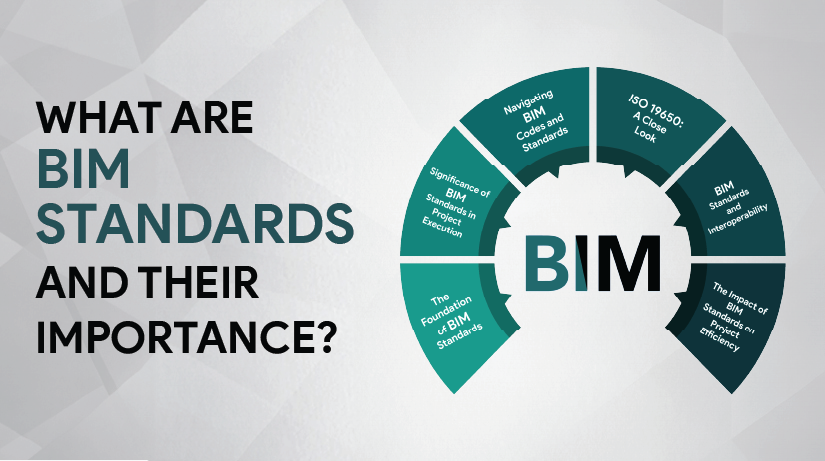What are BIM Standards and their Importance?
Jan 17, 2024
Category: BIM / Digitization / Automation
SEO TSA

In the realm of the AEC industry, BIM has risen to prominence as a revolutionary force. It is reshaping the way projects are planned, executed, and maintained. The success of BIM implementation is the strict adherence to established BIM standards – guidelines and protocols meticulously crafted to streamline processes and foster seamless collaboration among diverse project stakeholders.
At the core of this transformative methodology is the International Organization for Standardization’s (ISO) comprehensive framework, ISO 19650. This article delves into the significance of BIM standards, with an emphasis on ISO 19650. It highlights how these standards contribute to improved interoperability, heightened project efficiency and quality assurance, and sustainability.
The Foundation of BIM Standards
BIM standards, epitomized by ISO 19650, revolutionize the architecture, engineering, and construction industry. They provide a universal language, streamline collaboration, enhance interoperability, boost project efficiency, ensure quality assurance, and promote sustainable design. BIM standards are integral to advancing a cohesive, efficient, and sustainable future in construction.
Defining BIM Standards
BIM standards encompass a comprehensive set of guidelines, protocols, and best practices. These standards establish a unified approach to information management throughout the project lifecycle. The BIM standards foster collaboration by ensuring consistency in data exchange, and interoperability among software platforms.
The use of BIM standards also helps in effective communication among stakeholders. BIM standards have been proven to be beneficial, and advanced, and meet the new upcoming industrial needs. In essence, BIM standards provide the foundation for a collaborative and integrated workflow within the AEC industry.
ISO 19650
ISO 19650 is an international standard. It stands as a linchpin in BIM integration. It serves as a global framework for managing information throughout the lifecycle of a built asset. The standard emphasizes the importance of a Common Data Environment (CDE), Information Delivery Manuals (IDMs), and a clear classification system for information.
ISO 19650’s role is pivotal in promoting efficiency, reducing risks, and enhancing the overall quality of construction projects on a global scale.
Significance of BIM Standards in Project Execution
BIM standards play a pivotal role in project execution by providing a universal language and streamlined processes. They enhance collaboration, ensure data consistency, and foster efficient workflows, reducing errors and delays. They are crucial for achieving seamless and successful project outcomes in the AEC industry.
Enhanced Collaboration
BIM standards play a pivotal role in enhancing collaboration among project stakeholders. When everyone adheres to the same set of guidelines, communication barriers are minimized, and teams can seamlessly exchange information. This collaborative approach fosters a more integrated and efficient workflow, reducing errors and streamlining decision-making processes.
Improved Data Consistency and Accuracy
Consistency and accuracy in data are critical aspects of successful project execution. BIM standards contribute to improved data consistency by ensuring that information is structured and organized uniformly. This not only enhances the reliability of data but also minimizes the potential for costly errors during construction or facility management.
Navigating BIM Codes and Standards
Effectively navigating BIM codes and standards is pivotal in the modern construction landscape. It ensures seamless collaboration, data interoperability, and project efficiency. Professionals must align with industry-specific standards, such as ISO 19650, to unlock the full potential of BIM, fostering innovation and excellence in construction practices.
Understanding BIM Codes and Standards
BIM codes and standards are regional or industry-specific regulations that govern the implementation of BIM. These codes ensure that BIM practices align with local regulations and industry-specific requirements. Navigating through these codes is essential for professionals to ensure compliance with regional standards and deliver projects that meet legal and industry-specific criteria.
Adherence to Regional Regulations
In the AEC industry, different regions have specific regulations governing construction and design processes. BIM codes and standards are designed to align BIM practices with these regional regulations, ensuring that projects meet legal requirements. Professionals must stay informed about local codes to guarantee that their BIM implementations comply with the law and industry standards.
ISO 19650: A Closer Look
ISO 19650, is a pivotal standard in BIM. It revolutionizes the AEC industry. It fosters seamless collaboration through a universal language, streamlines data exchange, enhances project efficiency, ensures quality assurance, and integrates sustainability principles. ISO 19650 is the cornerstone for a more interconnected, efficient, and sustainable future in construction and design.
The Evolution of ISO 19650
ISO 19650 has undergone a significant evolution to keep pace with the rapidly changing landscape of the AEC industry. It was developed to replace the earlier ISO 12006-2 and ISO 16739 standards, unifying them into a comprehensive framework. This reflects the industry’s need for a standardized approach to BIM, emphasizing information management throughout the asset lifecycle.
Key Components of ISO 19650
ISO 19650 comprises key components that guide the efficient management of information in BIM processes. These components include a common data environment (CDE), information delivery manuals (IDMs), and a clear classification system for information. It emphasizes the importance of a collaborative approach, where stakeholders work together to create and manage a shared digital asset.
BIM Standards and Interoperability
The standard in BIM enhances interoperability within the AEC industry. These standards establish common protocols, fostering seamless collaboration among diverse stakeholders and ensuring effective data exchange. By promoting interoperability, BIM standards contribute to a more integrated and efficient workflow throughout the project lifecycle.
Interoperability Challenges in the AEC Industry
The AEC industry is characterized by the use of diverse software applications for its data formats and structures. This poses a significant challenge for interoperability—the seamless exchange of information between different software platforms. BIM standards address this challenge by providing a common framework that ensures data consistency and compatibility across various tools.
Facilitating Interoperability with BIM Standards
BIM standards play a crucial role in facilitating interoperability by defining common data structures and formats. When all stakeholders adhere to the same standards, data can be easily exchanged between different software applications without loss of information or formatting issues. This not only streamlines workflows but also enhances the overall efficiency of the project.
The Impact of BIM Standards on Project Efficiency
BIM standards enhance interoperability within the AEC industry. These standards establish common protocols, fostering seamless collaboration among diverse stakeholders and ensuring effective data exchange. By promoting interoperability, BIM standards contribute to a more integrated and efficient workflow throughout the project lifecycle.
Streamlined Project Workflows
The standards in BIM contribute to streamlined project workflows by providing a standardized approach to information management. This streamlining reduces the time and effort required to coordinate and collaborate among project stakeholders. As a result, projects progress more efficiently, meeting timelines and budget constraints more effectively.
Efficient Decision-Making Processes
In a BIM environment governed by standards, decision-making processes become more efficient and informed. With standardized information at their disposal, project teams can make decisions based on accurate and up-to-date data. This minimizes the risk of errors and ensures that project decisions align with the overall goals and objectives.
Ensuring Quality through BIM Standards
By establishing standardized processes and transparent communication, BIM standards minimize errors, enhance collaboration, and lay the foundation for reliable documentation. This adherence contributes significantly to the overall assurance of high-quality outcomes in the evolving landscape of the AEC industry.
Quality Assurance in BIM
BIM standards play a pivotal role in ensuring the quality of construction projects. By establishing standardized processes and procedures, these standards reduce the likelihood of errors and discrepancies in project information. This, in turn, contributes to the overall quality of the built environment, meeting or exceeding client expectations.
Minimizing Risks and Errors
One of the key aspects of the standards in BIM is their role in minimizing risks and errors throughout the project lifecycle. Whether in design, construction, or facility management, adhering to established standards reduces the probability of mistakes. This not only safeguards the integrity of the project but also protects stakeholders from costly liabilities.
The Role of BIM Standards in Sustainable Design
BIM standards, notably ISO 19650, are instrumental in advancing sustainable design. They integrate eco-conscious principles into the BIM process, guiding projects towards a more environmentally friendly and holistic approach within the architecture, engineering, and construction industry.
Sustainability in the AEC Industry
Sustainability has become a central focus in the AEC industry, with an increasing emphasis on environmentally friendly design and construction practices. BIM standards play a significant role in promoting sustainability by providing a structured approach to incorporating sustainable elements into projects. This ensures sustainability throughout the entire project lifecycle.
Facilitating Sustainable Decision-Making
The standards in BIM contribute to sustainable decision-making by providing a framework for assessing the environmental impact of design and construction choices. This includes evaluating materials, energy usage, and overall building performance. By incorporating sustainability parameters into BIM processes, professionals can make informed decisions that align with environmental goals.
Challenges in Implementing BIM Standards
BIM standards have challenges in the AEC industry. This includes resistance to change, diverse software compatibility issues, and the need for extensive training. Overcoming these hurdles requires a concerted effort to foster a culture of adaptation, address interoperability concerns, and invest in comprehensive education to ensure successful BIM standard integration.
Resistance to Change
One of the primary challenges in implementing BIM standards is resistance to change. Adopting new processes and guidelines can be met with reluctance, especially in industries with established workflows. Overcoming this resistance requires effective change management strategies, emphasizing the long-term benefits of BIM standards in terms of efficiency, collaboration, and project quality.
Training and Skill Development
The implementation of BIM standards lets a skilled workforce use BIM tools and establish protocols. Training and skill development programs are crucial to equip professionals with the knowledge and capabilities required to effectively implement BIM standards. Investing in ongoing training ensures that the workforce remains up-to-date with the latest industry practices.
Conclusion
In conclusion, BIM standards, with ISO 19650 at the forefront, are indispensable for the successful implementation of Building Information Modeling in the AEC industry. From enhancing collaboration and ensuring data consistency to facilitating interoperability and promoting sustainable design.
The BIM standards are the cornerstone of efficient and high-quality project delivery. As the industry continues to evolve, embracing and adhering to BIM standards is not just a necessity but a strategic move towards a more sustainable and collaborative future.
TechnoStruct Academy is the perfect educational institution for BIM training courses and certification programs. With a focus on BIM engineering tailored for designing and architecture, MEP, and BIM Management, TSA delivers specialized training. The academy goes beyond traditional approaches, offering project-centric and software-agnostic instruction suitable for both undergraduate and postgraduate students. Additionally, TSA creates opportunities for interns and graduates to contribute to its distinguished and revitalized projects.
FAQs
Q1. How many BIM standards are there?
Ans. There are several BIM standards globally, with prominent ones including ISO 19650, which provides international guidelines for BIM processes, and national standards like the National BIM Standard-United States (NBIMS-US). These standards aim to standardize BIM implementation, fostering consistency and interoperability across the architecture, engineering, and construction (AEC) industry.
Q2. What are the Level 3 standards of BIM?
Ans. Level 3 standards in BIM involve full collaboration and integration of all project stakeholders on a single, shared project model. Information is accessible in real-time, fostering a seamless flow of data throughout the entire project lifecycle. Level 3 BIM emphasizes interoperability, cloud-based collaboration, and a fully integrated digital approach to construction projects.
Q3. What are ISO standards for BIM?
Ans. ISO 19650 is the international standard for BIM. It establishes the principles and requirements for information management during the entire lifecycle of a built asset. ISO 19650 provides a framework for effective BIM implementation, emphasizing collaboration, data interoperability, and standardized processes for improved efficiency in the construction industry.








